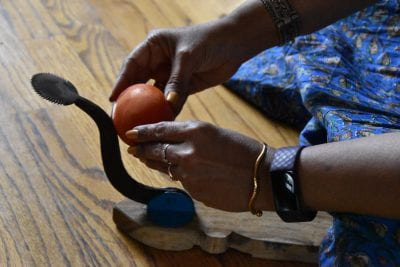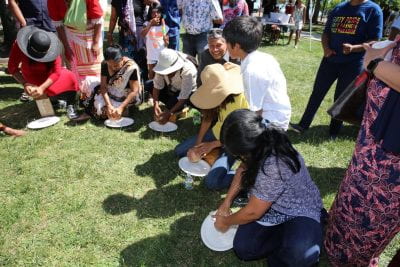Sounds of South Asia Exhibit Showcases Musical Traditions From Seven Countries

SJSU Collection Strategy Librarian Mantra Roy at the South Asians in Silicon Valley exhibit in SJSU King Library’s DiNapoli Gallery. The library will host a special evening of South Asian music on August 24. Photo courtesy of SJSU King Library Marketing Team.
Since publishing this article, Mantra Roy and SJSU King Library are excited to announce a new South Asians in Silicon Valley exhibit. The Sounds of South Asia exhibit, hosted in the DiNapoli Gallery located on the second floor in the Dr. Martin Luther King, Jr. Library, will be on display from July 2 – August 29, 2024. The exhibit showcases the musical traditions and sounds of instruments from seven South Asian countries — Afghanistan, Bangladesh, Bhutan, India, Nepal, Pakistan and Sri Lanka.
The exhibit will culminate with a special music event on August 24 from 10 a.m. to 2 p.m., on the second floor (Rm. 225) of the library where local musicians will demonstrate vocal and instrumental music traditions. RSVP now to secure your seat and experience this special opportunity.
In the heart of the Dr. Martin Luther King, Jr. Library on the fifth floor of the Africana, Asian American, Chicano, and Native American (AAACNA) Studies Center, SJSU Collection Strategy Librarian Mantra Roy points to silver cooking utensils in a display case. She remembers her grandparents using similar utensils cooking in their home in eastern India. Whether to cut vegetables, flip dosas or to break up clumps of boiled lentils, the visual representation of these utensils allows her to remember the comfort of her home country, beloved family, and the cultural traditions that have shaped her identity.
South Asians comprise almost 20% of the Bay Area’s population, but their stories are rarely told. The first of its kind for the SJSU King Library, Roy, along with library colleagues Kate Steffens, Nick Szydlowski, and Anamika Megwalu, connected with local communities to showcase the vibrant tapestry of the South Asian diaspora for their new exhibit “South Asians in Silicon Valley.”

A traditional knife, ‘Bothi’, used to cut vegetables and fish; the head of the knife is a coconut grater; used in eastern India and Sri Lanka. Photo: Nandana Das.
From intricately crafted artifacts to evocative photographs capturing moments of everyday life, each artifact tells a story — a testament to the resilience, creativity and diversity of South Asian communities from Afghanistan, Bangladesh, Bhutan, India, Nepal, Pakistan and Sri Lanka.
Since libraries serve as repositories of knowledge, Roy saw an opportunity to showcase the rich traditions, customs and histories of the South Asian diaspora. Through her exhibit, Roy seeks to educate, connect and celebrate the multifaceted identities of South Asians with the strong belief that the power of culture will unite, inspire, and transform lives.
We invited Roy to delve deeper to explore her goals of the exhibit and hopes for future South Asian programs. Please join her and the SJSU King Library during the “South Asians in Silicon Valley” exhibit reception on April 27, from 2–4 p.m. If you would like to get involved and contribute to the collection, contact Mantra Roy at Mantra.roy@sjsu.edu.
What does this project mean for you? And what do you look forward to most about this research project?
Mantra Roy (MR): The “South Asians in Silicon Valley” program will represent and showcase different aspects of the South Asian experience in Silicon Valley, or the larger Bay Area. The diasporas from these countries continue to cultivate their national cultures and traditions within their community spaces. The “South Asians in Silicon Valley” program will be the first opportunity for all of them to showcase, share and educate attendees and each other about their unique and shared cultures through a publicly accessible space, the SJSU King Library.
What are your goals for “South Asians in Silicon Valley” and how will it benefit SJSU and the local community?

The same ‘Bothi’ being used in a coconut-grating competition during a Sri Lankan New Year celebration. Photo: Sumudinie Fernando.
MR: The “South Asians in Silicon Valley” program will bring visibility to the lived experiences of the diasporas of South Asians in the wider Bay Area. Community members will experience acknowledgment of their contributions and impact because in spite of their numbers, very little is on record and publicly visible in public spaces such as libraries. Students and faculty of SJSU will gain the opportunity to study the rich complex South Asian diaspora from multiple perspectives, such as food habits, religious practices, music, entrepreneurship and more. Faculty associated with the Ethnic Studies mandate for CSUs will find many opportunities to develop curriculum around these library programs.
Why is it important for South Asian communities to be recognized for their contributions?
MR: The less we know of each other, the more biases persist. While the names of some South Asian tech sector leaders are well known in Silicon Valley, or the larger Bay Area, there are multiple sectors and various capacities in which the diasporas contribute, enrich and diversify the valley that are lesser known. On one hand, the South Asian communities thrive in their respective communal spaces that often end up being cultural silos. On the other hand, there are stereotypical images of these communities that circulate in mainstream media and perception. For example, unless someone is interested in Indian classical dance forms, they wouldn’t perhaps know that there are several schools/academies offering lessons in these forms for at least 50 years in the Bay Area. But many people would identify ‘Bollywood’ as a popular label for all South Asian music and dance forms.
Why are you including all seven South Asian neighboring countries in this project and what does it say about the intersectionality of culture?
The South Asians in Silicon Valley exhibit will be on display through August 29. Photo courtesy of the SJSU King Library Marketing Team.
Why is it important for librarians to be at the helm of public research projects like these?
MR: Librarians curate information to make it accessible to everyone. Curated information helps to preserve histories, legacies, and experiences. When founded on the principles of equity and diversity, the curation, preservation and facilitation of access to events and collections, helps libraries draw attention to underrepresented experiences and peoples. Community-engaged projects such as the “South Asians in Silicon Valley” program help librarians implement inclusion practices and create spaces for previously underrepresented stories. Such projects make belonging in institutional records possible. Librarians create programs to explore and showcase multiple aspects of a community and build collections to enhance knowledge about the community.
RSVP to attend the August 24 musical reception at King Library.




